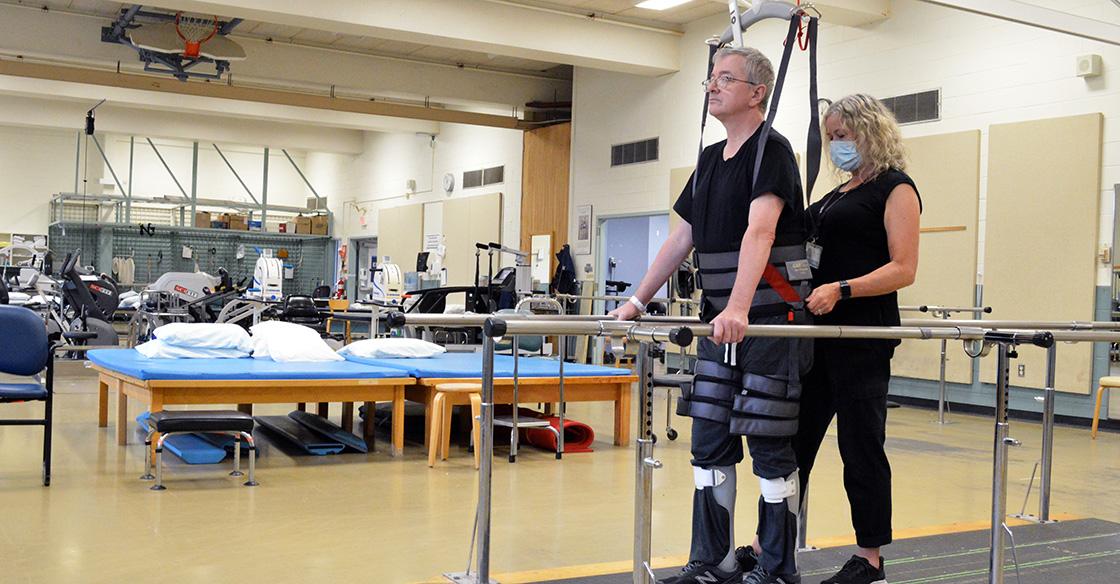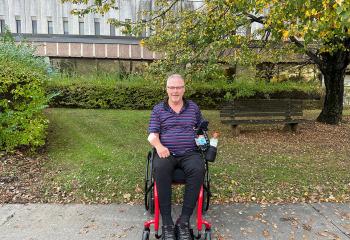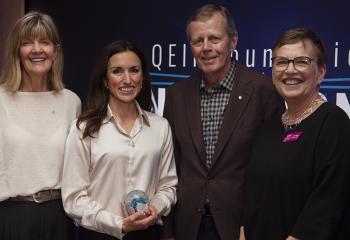
Barry Pettipas, with assistance from QEII physiotherapist Carolyn Cowan, used the body weight support system to help him learn how to walk again. Funded through a QEII Foundation Rehab Endowment Grant, the body weight support system is one example of how donors are changing the lives of QEII patients every day.
Last spring, a late-night fall changed the trajectory of Barry Pettipas' life. But after spending four months at the Nova Scotia Rehabilitation and Arthritis Centre at the QEII, the longtime produce manager from Chezzetcook says he knows he was in the right place.
“I was there for about four and a half months. It’s a long time, but I couldn’t get better care than what I received there,” Barry says. “I was in the right place.”
Barry severely bruised his spinal cord in the accident, which led to losing the use of both his hands, his right leg and some function in his left leg. The fall occurred on a Friday evening. By the end of the next day, Barry had gone through spinal surgery to help alleviate the swelling and strengthen his weakened spine.
At the time, Barry’s doctors weren’t sure he’d ever regain full mobility, but Barry continues to prove everyone wrong. In the last few months, he’s progressed through the help of regular physiotherapy to assisted walking of up to 90-metres at a time.
This road to recovery started with an innovative new body weight support system. Purchased in early 2022 with funds from the QEII Foundation’s Rehabilitation Endowment Grant, the X-Y body weight support system has helped patients like Barry regain the confidence to take those first steps.
The system, installed in the physiotherapy gym at the rehabilitation centre, provides patients and therapists with a safer means of working together. With the system’s support, patients who are physically challenged, obese, frail or at risk of falling can gradually put weight on their impacted limbs, allowing them to rebuild strength and coordination without the fear of falling.
“I started out fairly weak but as time went on, I was getting better and my legs were getting stronger,” Barry says. “I don't think it was much more than a couple of weeks, and I was walking a bit. It made a huge difference in my recovery.”
For therapists, the X-Y body weight system not only minimizes the risk of injury but improves facility operations and overall patient care, says Tara Moore, a QEII physiotherapist who works with neurological and spinal cord injury patients.
“This donor-funded grant and the support system we were able to purchase has opened new doors for our patients,” she says. “It allows us to treat more individuals simultaneously while significantly reducing the physical strain on our staff.”
The X-Y body weight support system has two modes, trainer and transfer mode, allowing therapists to cater to individual needs and goals with customizable settings. The system's dual-access design features parallel and perpendicular bars, enabling patients to unlock a wide range of movement, promoting balance and improved function. Therapists can also opt to restrict movement by locking access points for stability-focused tasks.
“It’s really helpful in terms of initiating the early stages of gait or working on progressing someone's gait as well as practising higher-level balanced tasks or more functional tasks,” says Tara.
Before the X-Y system was in place, therapists at the centre often needed to contort themselves into tight spaces and team up to keep the patient safe and secure during therapy. With patients now fully supported, therapists can focus on their patients in the moment.
“Before, if I was trying something without body weight support, maybe I’d have two or three extra therapists helping me facilitate that task to make sure the client was safe and supported,” Tara says. “It took a lot more planning, and then it would be limited based on colleagues being able to help you for a quick minute.”
The X-Y system, which attaches to a person’s thighs and torso and to a ceiling track above, provides new possibilities for patients.
“When we see patients in the rehabilitation centre, they often have new impairments in regard to their strength and balance, for example, so this system gives them the confidence to allow them to try those tasks without that added fear of falling,” Tara says.
Looking ahead, Barry is determined to continue his progress and eventually regain full mobility. With the support of the X-Y body weight support system and dedicated therapists like Tara, his journey toward a more independent future is brighter than ever.
“It definitely made a big difference for me,” says Barry. “Getting to take those first, assisted steps lifted my spirits and gave me a little bit of hope.”


